Mining Noise: Optimizing the Social Acceptance of Mining Projects Through the Successful Management of Noise Emissions [Guide]
Environmental, Sustainable Development, and Community Relations Professional in the mining sector: Are you managing mining noise complaints and experiencing challenges in the social acceptance of residents in neighbouring communities? This practical guide is for you.
Download the Free Guide
Mining Noise & Social Acceptance [Practical Guide]
For Community Relations and Environmental Management Teams
This guide has been carefully designed by our acoustics and vibration experts, who have been specializing in the mining sector for over 25 years. This guide contains essential principles to gain a better understanding of mining noise complaints and key methods for intervening effectively, as your mining project progresses. With our vast knowledge and experience, we outline in this guide the issues that pertain to common mining noise complaints, as well as provide you with concrete solutions to correct them.
This guide will serve to simplify the management of noise complaints from your operations, ensure harmonious cohabitation with neighbouring communities, and help to provide a successful social acceptance of mining noise related challenges.
|
BONUS — Download the Full Guide and Access Exclusive Content!
|
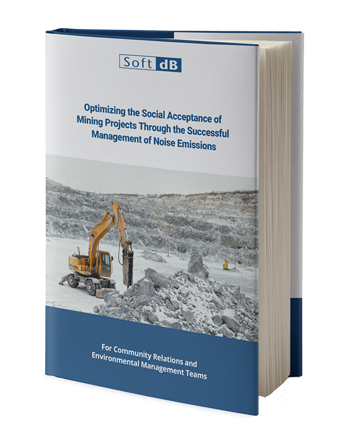 |

Introduction
Optimizing the Social Acceptance of Mining Projects Through Proactive Control of Mining Noise Emissions
Due to the nature of mining activities, the concerns most often raised by communities near mining sites generally include noise, vibration, and dust.
The growing importance of the social acceptance of projects stems directly from the potential impact on the quality of life that may be experienced by residents in the neighbouring communities. Whether it is the noise generated by mining activities, or the proximity of mining exploration activities to the community, the noise generated by the mine can not only have significant consequences for local communities, but can also jeopardize the very feasibility of the project.
Therefore, it is essential to take potential noise impacts into account at every stage in the development of a mining project. Doing so, will reduce the risk of generating noise pollution, safeguard the health and well-being of local communities, and ensure the sustainability of mining operations.
What Are the Noise Regulations in Canada?
All mining operations must comply with federal, provincial and local noise regulations and standards. There are different regulations that are applied in each Canadian province. Directive 019 in Quebec and NPC-300 in Ontario are examples of provincial regulations and guidelines that must be adhered to in order to obtain necessary permits to operate.
In Ontario, the Noise Pollution Control (NPC) documents are a set of guidelines published by the Ontario Ministry of the Environment, Conservation and Parks (MECP). These guidelines are applicable to the mining industry in Ontario, and aim to establish limits, measurement procedures, and assessment methods that are to be applied during the approval and planning process of the mine. The implementation of the NPC guidelines is to ensure that noise (NPC-300: Stationary and Transportation Noise Sources) and vibration impact (NPC-119: Blasting) on nearby sensitive lands is minimized and do not cause an adverse effect, as defined by the Ontario Environmental Protection Act (EPA). The limits and the assessment methods for noise & vibration are detailed in NPC-300 and NPC-119, as well as the supplemental documents NPC-101: Technical Definitions, NPC-102: Instrumentation, NPC-103: Procedures, and NPC-104: Sound Level Adjustments.
Achieving these standards is critical, not only to comply with legislation and maintain the mine's operating permit, but also to avoid various obstacles to project development, which could have a negative impact on project completion.
But is compliance with noise limits enough to ensure the social acceptance of a project?
In this guide, our engineers highlight other essential acoustic considerations to help ensure the social acceptance of a mining project.

Chapter 1
Acoustics 101 — Fundamental Concepts You Need to Know to Help Mitigate Mining Noise Issues
Before addressing and minimizing the mining noise issues commonly encountered during the various stages of a mining project, it is essential to master certain basic notions of acoustics.
1. Regulatory Compliance vs. Audibility: Being “Compliant” Does Not Equate to Being “Inaudible”
How Is Regulatory Compliance Assessed?
The specific method for determining compliance varies based on the jurisdiction in which the mine is located. In general, a mine's noise compliance is assessed by taking measurements over a period of time in various areas surrounding the mine.
In accordance with regulations, the results of sound measurement levels are usually averaged over a predefined period of time, such as 1 hour, 24 hours, etc. This may be suitable for operations with steady operations and relatively stable noise emissions. However, for operations with variability, the measurements of the instantaneous sound levels may vary significantly over this time period. Given this variability, levels may be higher or lower at certain times. Additionally, the measured sound levels may also include various environmental sounds (e.g. cars, wildlife, human activities, etc.). These noise compliance measurements are therefore, often not representative of the mine's perceived noise contribution.
To summarize, a noise compliance assessment, which is based on an average sound level over a period of time, often does not account for short-term noise fluctuations and may not provide an accurate representation of the mine’s perceived noise emissions.
In addition to the assessment period, these regulations are generally based on a noise target (numerical value) to be met, such as an ambient noise level, or a fixed noise level when the ambient level is too low. The ambient noise level is the noise that is existing in the environment, without contribution from the mine.
“Compliant”, Yet “Audible”?
Understanding the difference between "noise compliance" and "audibility" is essential for community relations and environmental teams. Although mining activities may be compliant, they can sometimes be audible and cause a nuisance for the neighbouring communities.
Fortunately, various strategies can be put in place to minimize the impact of noise contribution from mining.
|
To illustrate the difference between "compliance" and "audibility", let's take the example of a mine that is set up in a remote region, far from residential areas, and begins its operations having complied with the necessary noise standards. At first glance, it might seem logical that the mine should be less audible to surrounding communities, given its distance from residential areas. However, the reality can be more complex than this. A mine may actually be audible if it is located in a very quiet area near a lake, for example. Why is this so? → The human ear is able to adapt to the noise level of its environment. Ambient noise, sometimes termed as "residual noise", is characterized by any noise that persists in an environment. In our example above, the natural sounds of the lake environment provide a low residual noise, without the contribution of the mine's activities. Therefore, the human ear has adapted to this low level of noise. |
In very quiet environments, very faint sounds can become easily perceptible, such as the flight of an insect.
Even if the insect is not noisy compared to a mechanical shovel, for example, it may become perceptible due to the low level of ambient noise to which the human ear has adapted. This adaptation of the ear to ambient noise also applies in noisier situations. Do you remember hearing an insect flying about in a bar? Wouldn't that have been surprising? In fact, your ear has adapted to the bar's high noise levels. The audibility of a noise therefore depends on the existing sound environment. This is a key aspect to consider.
Let's imagine an environment where the ambient noise, i.e. noise without mining activities, is very low, say 15 dBA, whereas the compliance level is set at, say, 40 dBA. In theory, a noise contribution of 30 dBA from mining activities would technically be compliant1. However, in practice, considering that the contribution of this source would be 15 dB above the existing ambient, this activity would be clearly audible.
Thus, regulatory compliance is not a guarantee of the social acceptance of a mining project, especially in areas where ambient noise is low.
1. Note that noise is added on a logarithmic scale. As such, an ambient level of 15 dBA plus a noise contribution of 30 dBA from mining activities would add up to a total of 30.1 dBA.
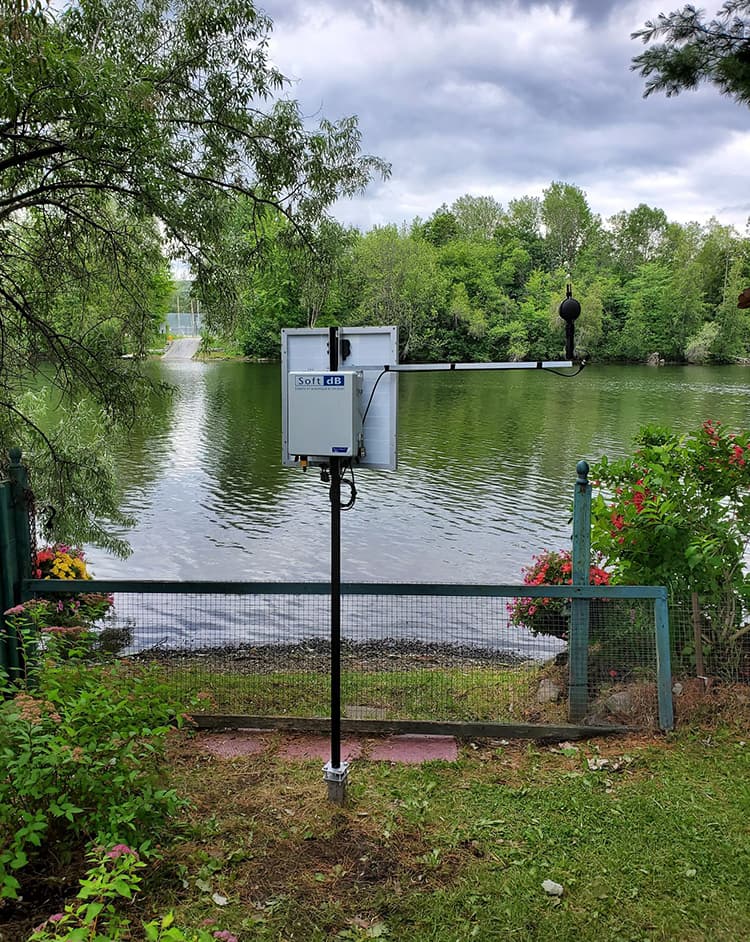
Let’s face it, there’s no such thing as zero noise emissions from a mining project. It's impossible to design a mining project without generating a certain degree of noise.
So, what is the best strategy for ensuring harmonious community relationships?
We will address that shortly, but for now, let's continue with a few basic notions of acoustics, which will give us a better understanding of the concepts needed for effectively managing mining noise complaints.
2. Mining Noise Sources that May Increase Community Complaints
Noise complaints are not only caused by an overall increase in noise levels. In the case of mining projects, there are typically specific noises that are the source of disturbance for neighbouring communities.
Beyond the project noise contribution and ambient noise of the sector, many factors can also influence noise perception, such as the characteristics of the noise emitted.
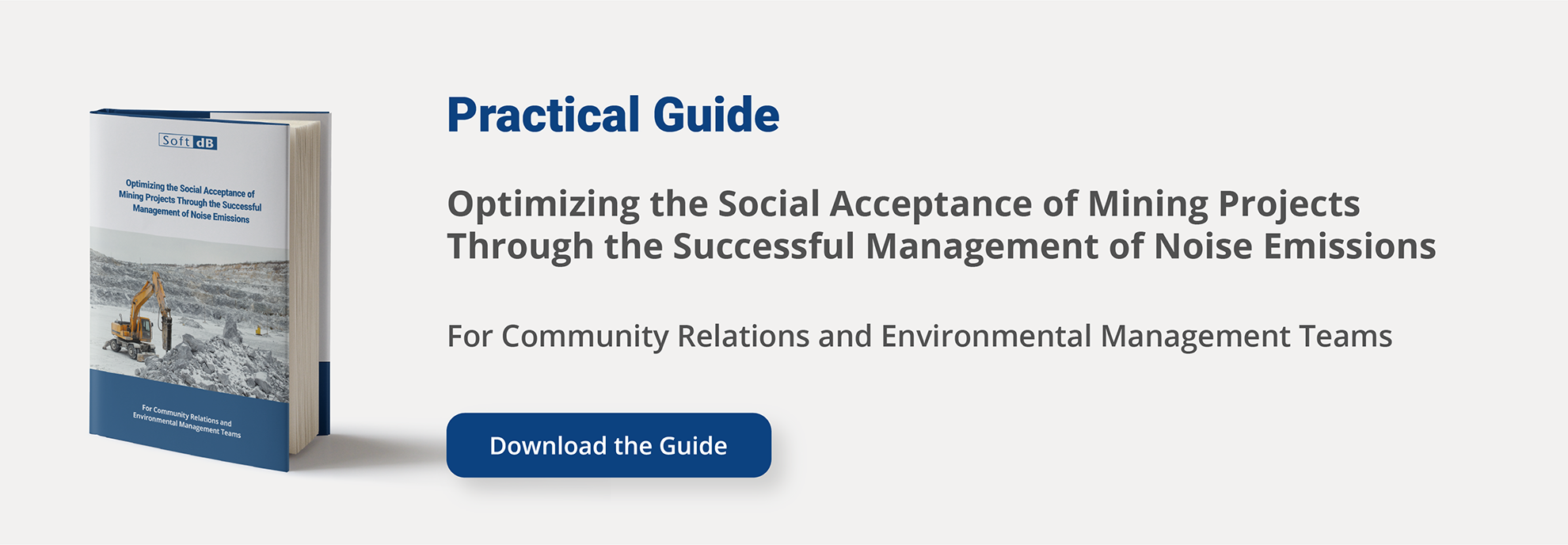
Here Are Some Common Examples of the Types of Noise and Their Sources at Mining Sites:
Continuous noise: This type of mining noise is generally associated with equipment that is in constant operation, with low noise variability, such as crushers. It is characterized by a continuous, stable sound emission over an extended period. Other examples of continuous noise sources are ventilation systems, pumps, baghouses and other rotating equipment that is in continuous operation.
Continuous noise of a crusher
Sporadic noise: Unlike continuous noise, sporadic noise is produced by specific, intermittent activities; such as trucks unloading, or travelling along haul roads and the stopping and starting of certain equipment. The sound may be brief, but its contribution may be higher during this period, making it more noticeable.
Sporadic noise from a tracked excavators
Impact noise (impulsive): Certain noises can also be "impact noises", since they can lead to a short, but significant increase in noise levels. A good example of impact noise is a hydraulic hammer.
Impact sound from a hydraulic hammer
Tonal noise: This is noise that is continuous in which most of the acoustic energy is centered around a particular frequency, as in the case of certain mining fans. If you can hum or whistle the sound, it’s most likely a tonal sound.
Tonal noise from a mining fan
Low-frequency noise: This is a noise that is mostly concentrated in low frequencies and tends to carry over much longer distances. This type of noise can resemble a “rumbling” sound and may sometimes cause objects to shake or rattle (e.g. windows, picture frames, etc.) and therefore often gets mistakenly identified as vibrations.
Now we know that mining noise sources that can cause disturbances are not necessarily the loudest.
The average noise contribution of a screening plant may actually be greater than that of a truck unloading operation. However, since the noise from the screening plant is continuous and the human ear has gradually adapted to this type of noise source, the screening plant is likely to become less perceptible than a truck unloading operation. Therefore, unloading trucks will be more likely to produce noise complaints from the surrounding communities.
3. The Nature of Noise Should be Considered when Managing Complaints
The perception of noise is largely based on the nature of the noise.
For example, if crickets were to emit a sound of 60 dBA in the middle of nature, this may be quite tolerable, even pleasant. On the other hand, the sound of an excavator producing only 40 dBA in the middle of the night, will likely be perceived as more disturbing, as we typically expect to hear the natural sounds of wildlife, not those of mining equipment.
→ Therefore, the nature of a noise is a factor that needs to be taken into account in acoustic monitoring projects for mining sectors.

Chapter 2
The Different Phases of a Mining Project, Their Respective Noise Challenges and How to Avoid Them
Now that we're familiar with some of the fundamental concepts in acoustics, let's explore the noise issues inherent in each phase of a mining project, putting forth effective measures to prevent mining noise pollution and nuisance, and minimize the risk of noise complaints.
Mining projects are generally divided into five phases: 1) Mining Exploration, 2) Authorization, 3) Construction, 4) Operation, and 5) Rehabilitation.

Mining Exploration
A Common Situation that Raises Noise Issues and Often Leads to Complaints
During the exploration phase of a mining project, equipment such as drill rigs, pumps and generators generate noise, and sometimes around the clock. In addition to being noisy, they are often located in quiet natural environments, in close proximity to communities.
Have you done the math?
Noisy equipment + operating close to residential areas + relatively low ambient noise (to which the human ear has adapted) = recipe for unwanted noise, increased likelihood of noise complaints and community opposition of the project.
Although exploration activities are generally of short duration compared to other phases of a mining project, they can still produce a significant noise disturbance. Excessive noise frequently leads to complaints, and can even bring operations to a halt.
How to Avoid Noise Pollution Exposure During the Exploration Phase
Firstly, it can be very effective to install high-performance noise mitigation solutions directly at the noise source, such as our acoustic curtains.
Next, comprehensive monitoring of noise emissions is required, using state-of-the-art monitoring stations, which measure the noise and vibration levels in real time. This means that you can be alerted instantly when field equipment exceeds acceptable noise level thresholds. Those thresholds should be discussed with your Acoustical Consultant.
Having access to live monitoring information is just as if you are directly in the field. You'll be able to intervene quickly, efficiently, and effectively, wherever you are. Soft dB noise and vibration monitoring stations are the ideal solution for this purpose.
Not only can you monitor your noise emissions live, but you can also set up alerts and set noise parameters to be monitored, even before established thresholds are exceeded. This allows you to identify the source and quickly rectify the situation to minimize the mining noise impact on the surrounding community.
In addition, Soft dB has developed a custom monitoring solution for drill rig operators, instantly informing them of any risk of noise levels being exceeded. Our expert acoustical engineers have successfully applied this method to numerous mining projects.
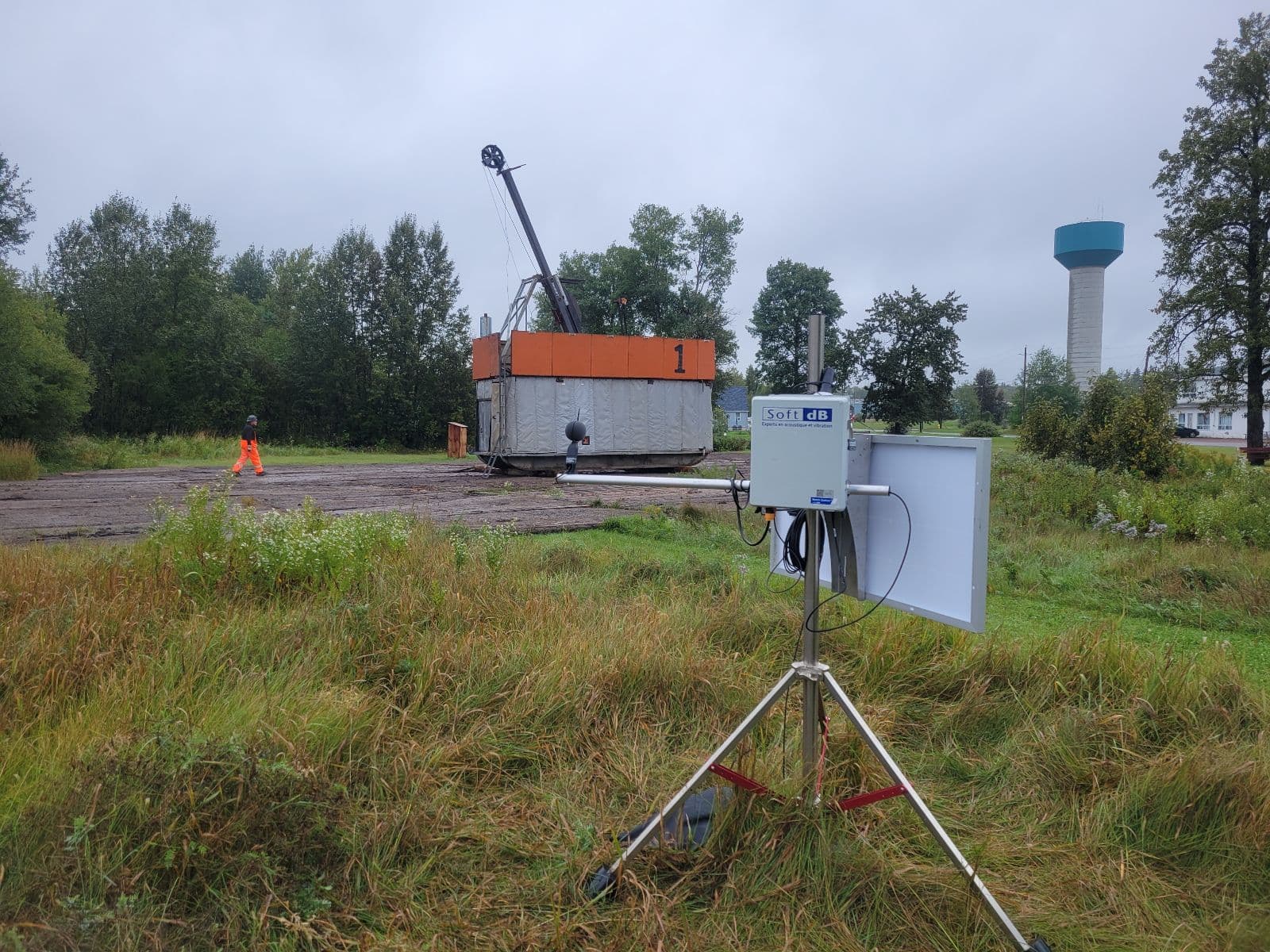


Construction and Operation of a Mine Site
Common Causes of Noise Issues and the Strategies to Address Them
Even after an application for authorization to build and operate a mining project is approved, once the project is in its construction and operation phases, you may still receive numerous complaints and opposition from neighbouring communities due to mining noise.
Why is this the case?
Construction Phase

During the construction phase: New sounds become audible in the community. The sounds that residents were previously accustomed to hearing during earlier phases of the mining project have changed.
- Residents are hearing new, sporadic, and variable noises, which differ from day to day.
- These noises are generally produced by mobile equipment, whose noise contribution can vary greatly from one moment to the next depending on their location and activity.
- These activities take place mainly during the day, with noise levels increasing in the morning and decreasing at the end of the day.
The noise now being emitted from the construction operations has become the residents’ new reality and in order to maintain a positive relationship, it is important to take their concerns into consideration.
Operating Phase

During the operating phase: the noise environment changes once again.
- Presence of new noises (e.g. drilling, blasting, mine ventilation, etc.). These sound sources generally have specific acoustic characteristics, which often make them more perceptible. As a general rule, sound pressure measured at a distance of 10m from a typical exploratory drilling rig, can typically reach sound levels of between 80 and 90 dB(A).
- Most sound sources are now operating continuously, 24/7.
Generally speaking, these are the most common causes of noise complaints due to changing sounds in the environment:
1) The theoretical study (Noise Impact Assessment) underestimated your actual mining noise contribution:
In the field, the equipment that was chosen may differ from what was modeled during the noise impact study or during the detailed engineering phase; hence the importance of conducting a thorough initial noise study. In addition, certain factors, if not taken into account (e.g. weather conditions such as wind direction, temperature inversions, etc.) can affect sound propagation and may have a significant impact.
2) You are compliant, but audible:
a. The existing ambient noise may be lower than the noise targets considered in the study, due to measurements taken over a short period of time. Low ambient noise, i.e. noise in the environment without mining activities, increases the likelihood that the mining noise activities will be audible in the surrounding community.
b. The ambient noise level may be higher, but some specific noises, such as impact sounds, tonal sounds, low frequencies, etc., are audible. As indicated in many regulations, these types of noises often require the addition of a penalty to compensate for the enhanced perception (and thus annoyance) of these sounds. For example, the sound of an excavator may last for a brief moment, yet rise above the ambient noise and be clearly audible. However, if the overall sound is averaged over an hour, its contribution may be negligible.
If a resident expresses noise concerns, it may be difficult to identify the exact source of the disturbance. However, it's important to take these reports very seriously, even if the level of detail available at the time of reporting is often incomplete and complicates identification of the problematic source.
→ It's your responsibility to be in full control of your mining noise emissions. Our environmental monitoring solutions are here to help you do just that.
How to Minimize Impact During Construction and Operation Phases
To put yourself in the shoes of the community and fully understand their reality, a high-performance noise monitoring solution incorporating continuous sound recordings is a first-rate solution.
If a sound monitoring system only allows you to measure a single metric, say 30 dBA overall, how do you determine the cause of a complaint, identify audible noises or even know your noise contribution when you are within compliance?
|
It is essential that your noise monitoring system provide you with continuous sound recordings, so that you can listen back precisely to the moment when the complaint occurred, and thus accurately identify the noise nuisance, whether above or below regulatory limits. Numbers alone are not enough. Effective monitoring should not limit you, but help you get to a solution. |
Typical Situation Leading to Mining Noise Complaints Regardless of the Phase of the Mining Project
|
Regardless of the phase of a mining project, a situation frequently experienced by community relations professionals usually leads to noise complaints. Download the guide to learn more about this situation, so you can better adapt your strategies and promote harmonious cohabitation with neighboring communities. |

Chapter 3
Noise Monitoring With Continuous Audio Recording: Your Solution of Choice for Mining Noise Complaint Management
Monitoring noise levels with continuous sound recording facilitates the understanding of events that resulted in noise complaints.
|
Imagine a crusher that operates continuously, 24/7 and the neighbouring communities are used to the continuous drone noise it produces. Suddenly, a contractor has a back-up alarm on his truck that emits a familiar yet annoying "beep-beep" sound over short periods during the hour. This change in sound character may be audible and can lead to complaints since this is a safety system that is designed to generate more noise than what surrounds the equipment. Despite being louder for short durations, if we look at average levels over an hour, the noise contribution of the back-up alarm is marginal. As we’ve seen, the disturbing noise is not necessarily the loudest noise or at a level exceeding the regulatory noise limit, but it has a characteristic that causes it to be annoying. |
→ In this case, the use of noise monitoring with continuous audio is essential. You can listen to the audio of the recording to identify the exact source of the problem and take corrective action immediately.
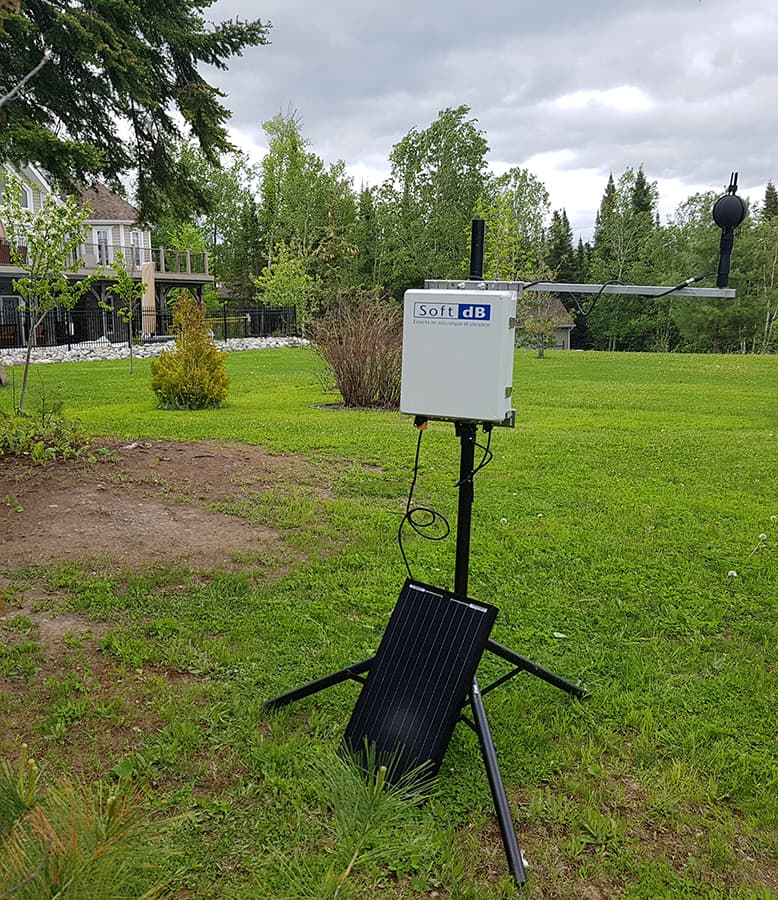
[Free Webinar Replay] Noise Management: How to Design Mining Exploration Projects for Social Acceptance
Are you dealing with noise complaints and facing challenges with social acceptance in the mining sector, especially during the exploration phase?
This webinar, presented by renowned experts in acoustics and vibration, is for you!
Discover some essential acoustic elements, enhance the social acceptance of mining exploration projects, and strive for harmonious coexistence among neighboring communities.
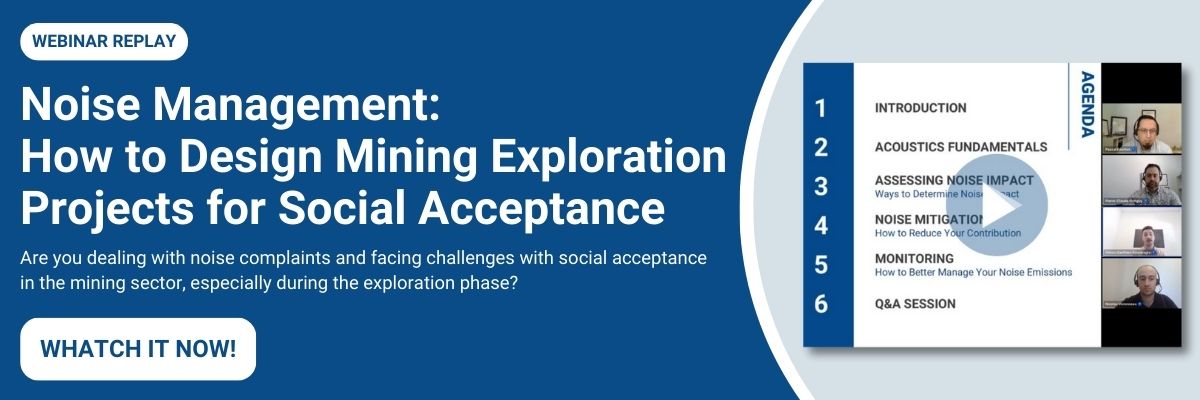

Chapter 4
Why Continuous Noise Monitoring is an Important Tool in the Social Acceptance of a Mining Project
Mining projects are not always situated in close proximity to communities. They may be located in a quiet environment, where ambient noise is low, and sound levels may vary on a daily basis, according to weather conditions, natural sounds, wildlife, human activities, etc. For example, for a source located at a distance of one kilometer from a residence (referred to here as a "receptor"), the presence or absence of winds between the source and the receptor can lead to drastic changes in the sound environment.
Noise Monitoring Prior to the Start of Mining Activities
For a mine, continuous noise monitoring may be relevant prior to construction activities, in order to establish the ambient noise level, enabling a comparison of noise contributions before and after the start of operations.
It also helps to assess and document potential community relations issues as well.
By installing permanent noise monitoring stations, depending on the ambient noise levels measured, adjustments can be made to mining activities. For example, if the existing ambient noise was 27 dBA and the mining activities increase the level to 38 dBA, even if this complies with regulatory limits, it can be audible and therefore may be disturbing for some residents, as the noise level would be perceived as being twice as loud.
Continuous sound monitoring adds value to the understanding of the situation.
Pro Stations for Community Relations Management
The noise and vibration monitoring stations such as the Watch™ and the Pro Stations developed by Soft dB, are specifically adapted for community relations management.
Soft dB’s noise monitoring stations offer exceptional audio quality with a built-in weather module, handy for filtering out sound events caused by extreme weather. They are strategically positioned in the field by our team that specializes in data analysis and processing. See our range of noise monitoring services.
In order to be able to filter through all of the collected data and be able to better understand the causes of noise complaints, it is often necessary to perform acoustic signature and noise level analyses. This requires analysis of the frequency content of the signal, either via a Fourier transform or a one-third octave band representation.
These advanced tools make it possible to represent the distribution of frequencies contained in a sound signal.
→ Soft dB noise and vibration monitoring stations enable this type of analysis in real time, and allow users to go even further in analyzing complaints and understanding noise issues.
When dealing with community relations issues, you don't necessarily need to look at the loudest noise measured during the hour. Rather, you need to understand all the noises measured during the hour in which the complaint occurred.
If your noise monitoring station records audio with excellent quality, it's easier to conduct an analysis and put yourself in the resident's shoes to find out what led to the complaint. The loudest noise is not necessarily the most disturbing noise.
Pierre-Claude Ostiguy, Ph.D., Engineer, Sound and Vibration Monitoring Expert

Conclusion
Achieving Social Acceptability of Your Mining Project in Terms of Noise: A Mission More Than Possible
To favour the social acceptance of a mining project with neighbouring communities, it is essential to properly manage noise from activities on site to prevent the noise from becoming a problem.
Measuring, identifying and minimizing mining noise nuisances at every phase of a mining project, while complying with standards and regulations, is crucial to preserving the quality of life of local communities and ensuring the sustainability of mining operations. In addition to measurement, adequate knowledge of site-specific noise conditions is also essential to the success of a mining project.
Monitoring with continuous audio, such as Soft dB's Class 1 monitoring solutions, facilitates accurate understanding of events that could lead to noise issues, and is therefore a must-have tool for all community relations and environmental teams.
We hope this guide has helped you better understand the basics of mining noise and what may lead residents to become concerned about or complain about noise, the key methods for intervening effectively, and the major role of continuous noise monitoring solutions, in achieving the social acceptance of mining projects.
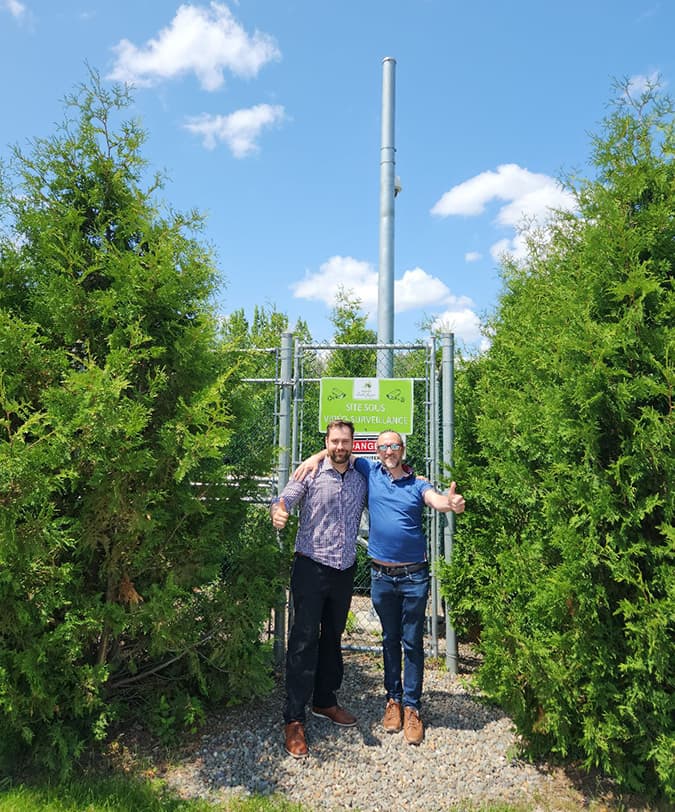
|
BONUS — Download the Full Guide and Access Exclusive Content!
|
 |
This practical guide incorporates knowledge and observations drawn from thousands of Soft dB projects in the mining sector.
As each project is unique, it is important to emphasize that this guide cannot replace the specific analyses of a qualified acoustics and vibration expert.
All projects must be assessed on a case-by-case basis.
Need to Optimize Noise Management in Your Mining Project?
No matter how complex the challenges of noise and vibration in the mining industry, our engineering teams offer tailor-made solutions for successful social acceptability and harmonious cohabitation between the mine and neighboring communities.
Contact our experts in mining noise